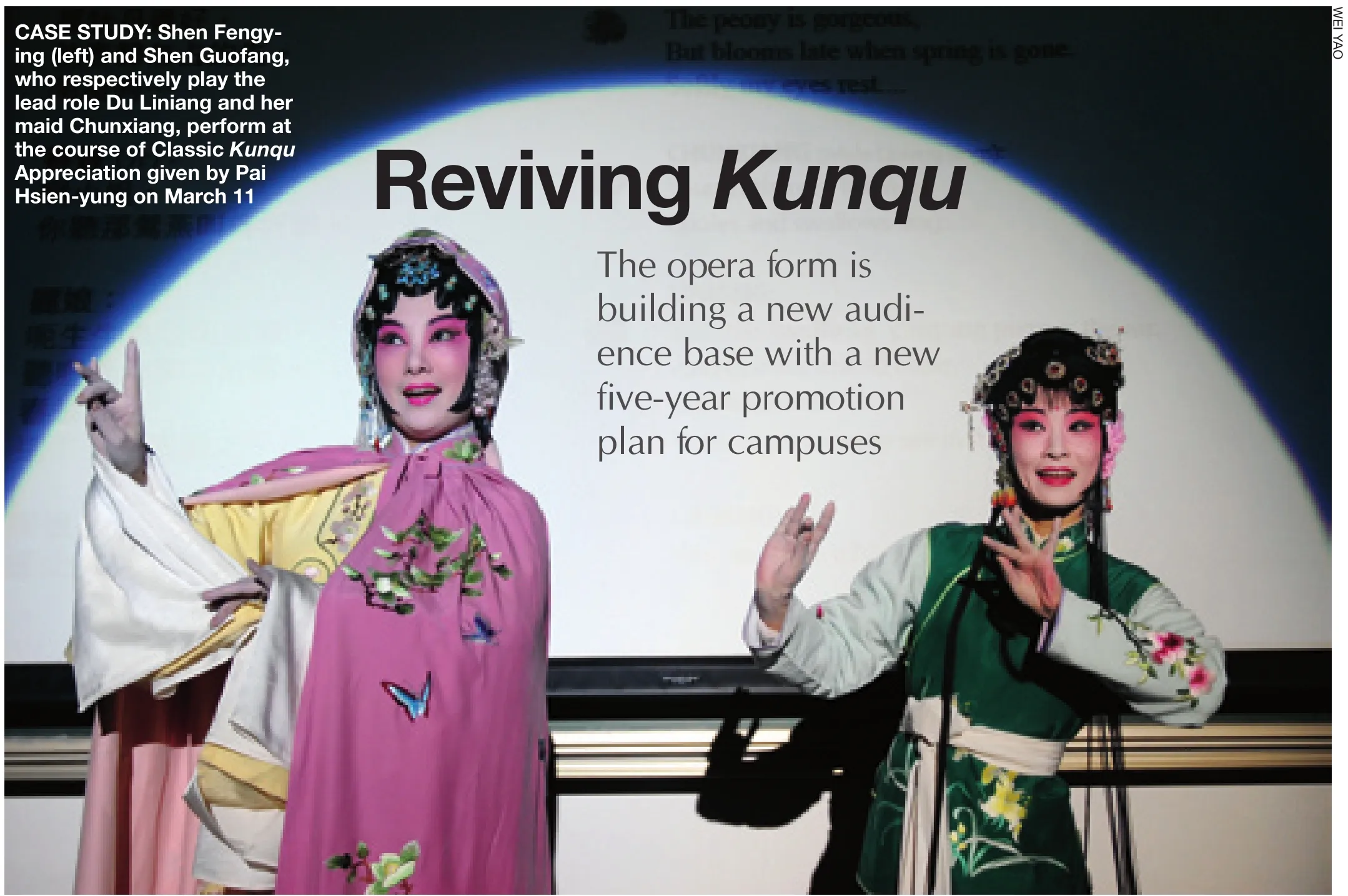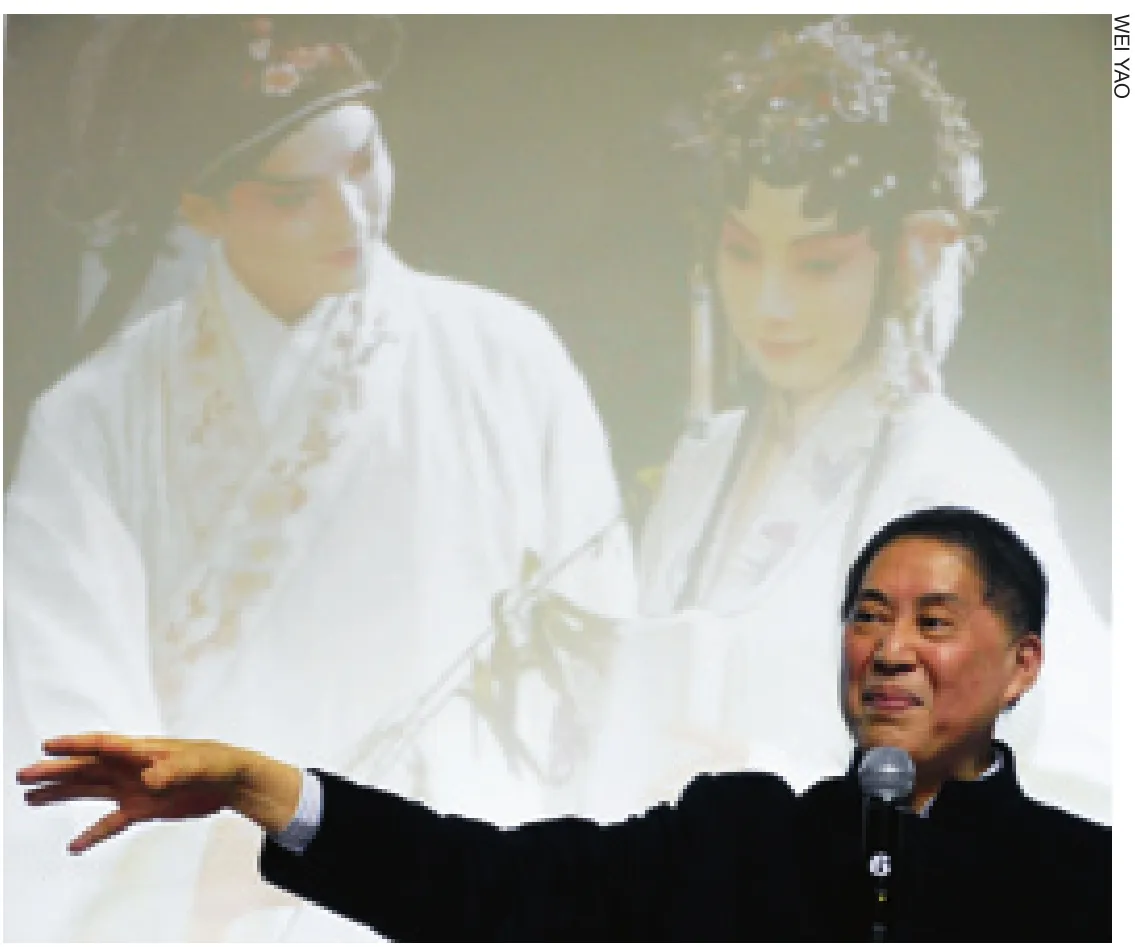Reviving Kunqu
2010-03-15DINGWENLEI
The opera form is building a new audience base with a new five-year promotion plan for campuses

By DING WENLEI
An optional course for university students at Peking University is attracting students to crowd the 300-seat classroom. Many sit in aisles or stand at the back and in entrances. They come because of the charisma of the lecturer, Taiwanese author Pai Hsien-yung,and the exquisite art of China’s oldest opera, Kunqu.
Pai, a professor emeritus of modern Chinese literature at the University of California, Santa Barbara, has established a reputation as a determined and ardent promoter of Kunqu.
Occasionally he resumes his role as a teacher to give lectures on Kunqu to young audiences in universities. His March 11 lecture of fi cially kicked off an ambitious fi veyear plan to promote and pass on Kunqu to future generations.
The plan begins with an optional course,Classic Kunqu Appreciation, which will cover all aspects of the art form. During the three-month course, professors from Hong Kong, Taiwan and the mainland will interpret China’s traditional aesthetics and literary heritage, while the production team for Pai’s adaption of The Peony Pavilion, a classic repertoire of Kunqu, will elaborate on aesthetics involved in stage design, script adaptation and shooting.
As a parallel activity, actors and actresses are being selected from young fans of Kunqu in universities to be instructed by maestros Wang Shiyu and Zhang Jiqing, in creating the campus version of the lightly modernized The Peony Pavilion.
I’m home once I hear it
Mei Lanfang (1894-1961), a master of Peking Opera as well as Kunqu, staged a scene of The Peony Pavilion, called The Interrupted Dream, in Shanghai in 1946.The performance planted the seeds of a love affair with the opera form in the heart of 9-year-old Pai, son of Kuomintang General Pai Chung-hsi.
Pai and his family settled in Taiwan in 1952, where he studied English literature in Taipei and became an author. He went to the United States to study literary theory and writing in 1963 and became a professor of modern Chinese literature at the University of California, Santa Barbara, in 1965.
Inspired by Kunqu, Pai wrote a short story The Interrupted Dream in 1966, about the different fates of former actresses of the Suzhou Kunqu Troupe who married Kuomintang of fi cials, settled in Taiwan and reunited years later at a birthday party where they perform several scenes.
While writing, Pai played some Kunqu classics on a gramophone.
“I felt as if I was at home when I heard them,” he said. “Memories of my boyhood flashed back, and it also reminded me of many stories I heard during my childhood.”
But by then, Kunqu had already begun to decline on the mainland and in Taiwan,with few troupes able to perform a complete story. In 1982, Pai adapted his book The Interrupted Dream into a stage play.A year later, he produced two acts of The Interrupted Dream in Taipei.
After half a century’s experiences of cultural clashes, Pai was looking for an answer to the question∶ How can modern China be culturally powerful by reviving its rich cultural heritage?
“I strived to fi nd a balance and combination between Western and Chinese, ancient and modern cultures when I was young. I have seen both the merits and demerits of both cultures during this process,” he said. “I realized the most beautiful peony was in my own courtyard, and I decided to return and cultivate the peony.”
Passing the heritage on
Pai said he prefers inheritance to heritage in describing Kunqu, because the genre is still alive. But the art form had showed any sign of revival until 2004 when the “Young Lover’s”version of The Peony Pavilion adapted by Pai was premiered in Taipei and its 9,000 tickets sold out a month before the performance.
The 600-year-old Kunqu was listed by UNESCO as a “Masterpiece of Oral and Intangible Heritage of Humanity” in 2001,and the listing has prevented it from fading away.
Kunqu’s appeal dwindled about 200 years ago when Peking Opera overtook it as the dominant form of popular entertainment. The situation was aggravated during the “cultural revolution” when many Kunqu troupes were disbanded. Today,Kunqu is widely viewed as a highbrow pastime for the educated and wealthy. The exquisite art form even lost its audience in Suzhou, east China’s Jiangsu Province, where it originated.
Pai’s passion for Kunqu was rekindled in 1987 when he returned to the mainland for the first time as a guest professor at Shanghai Fudan University.There he was overwhelmed by the wonderful performance of Cai Zhengren and Hua Wenyi,leading artists of the Shanghai Kunqu Opera Co.
This inspired him to produce a two-and-a-half-hour version of The Peony Pavilion featuring Hua in Taipei in 1992, but that was still far from realizing his dream of staging a complete Kunqu production.
Comparing the mainland to Taiwan,Pai said the latter has a solid audience base for Kunqu but less well-trained performers,while the mainland had the best performers but a shrinking audience and low performers’ incomes.
Thanks to decades of promotion in Taiwan’s colleges, Kunqu enjoyed a much younger audience than Peking Opera in Taiwan, said Pai. Young Kunqu fans have been told not only to catch every line of the opera but also to understand the subtle meanings of each move and the singing.
Based on Taiwan’s successes and his multicultural background, Pai realized there were two directions for promoting Kunqu∶ It must win a large audience on campuses and establish connection with an overseas audience.
Pai wanted modernized, “more beautiful” productions catering to young audiences and with universal themes. In 2002, he discovered two candidates, Yu Jiulin and Shen Fengying, perfect for the leading male and female roles in The Peony Pavilion and invited two Kunqu maestros Wang Shiyu and Zhang Jiqing to train them to perform in his adapted version for youth. Different from the original text that contains other subplots,Pai’s adaptatio
n
focuses on the love story between Du Liniang and Liu Mengmei, the main characters in The Peony Pavilion.

TELLING A LOVE STORY: Pai Hsien-yung lectures to a crowd of college students on the aesthetics of Kunqu, citing the example The Peony Pavilion
Since its premiere in 2004, the ninehour, three-night show has been performed 184 times on the mainland, in Taiwan, the United States, Britain and Greece to great acclaim. This was carried out with sponsorship from the Hong Kong-based Robert H.N. Ho Family Foundation and others of 30 million yuan ($4.4 million).
Its success came from a perfect blending of tradition with innovation. “The biggest challenge is how to combine tradition and modern aesthetics, how to revive the 600-year-old art on the 21st-century stage,” Pai said. “We use modern lighting, costumes and settings but the acting, narrative and singing retain a traditional style.”
Applying this belief, Pai staged The Jade Hairpin, another adapted version of a Kunqu production for youth, also performed by Yu and Shen, at Peking University last December.
“I feel happy for the young audience at Peking University who have fallen into love with Kunqu, because I have been worried that they, not long familiar with China’s classic works, would not be as steadfast as I am in loving them,” Pai said. “It’s my greatest reward to see China’s classics still glittering on the modern stage and moving these young people.”
Cultural identity recognition
With the launch of the five-year Kunqu Inheritance Plan, Pai aspires to a bigger goal.
“I expect a new round of cultural revival as young Chinese pick up courses on China’s traditional culture and revalue cultural traditions, because I think college students today are all looking for a cultural identity,” he said at the launching ceremony of the program on March 11.
The plan will include the optional course at Peking University, performances,exhibitions and lectures, a digital corpus for Kunqu repertoire and a special fund for Kunqu Inheritance.
Pai insisted on cultivating future audiences for Kunqu in universities. Except for 39 shows overseas, a majority of 184 shows of The Peony Pavilion were given in universities on the mainland.Half of the tickets for performances at universities were priced relatively inexpensively, at “several dozen yuan($4-8).”
Thanks to nationwide campus promotion, the show has earned a loyal following.Nearly 100 students from universities in Beijing attended the March 18 audition to stage the campus version of The Peony Pavilion.
Jin Gu, a postgraduate student who majors in Digital Arts at Peking University surprised the panel with his performance.Jin said he became interested in Kunqu five years ago and came along for the chance to be instructed by Kunqu maestro Zhang Jiqing, one of the judges.
“Kunqu is a comprehensive art form, a combination of traditions and performance.The most dif fi cult part of it is the text and the accents,” Jin said. “You have to remember all these lines before practice.”
Pai has many hopes∶ that more universities will offer Kunqu courses; that experts and scholars cooperate with Kunqu troupes to produce quality shows; to have a theater devoted to Kunqu performances beside beautiful gardens in Suzhou.
But he knows that he can not accomplish this by himself and the success of one show does not equate to a revival of Kunqu. ■
